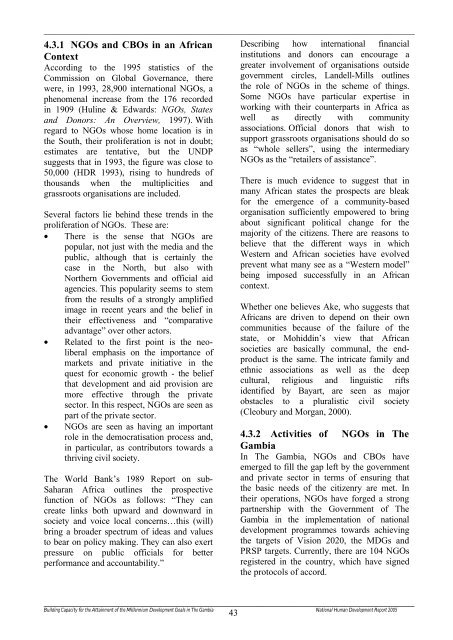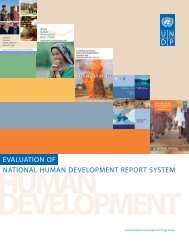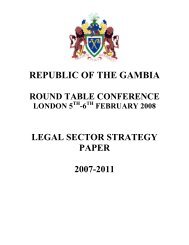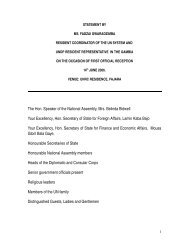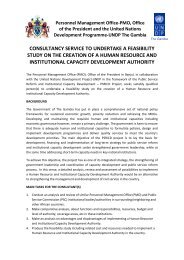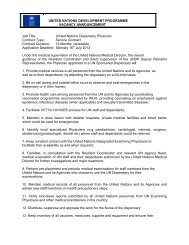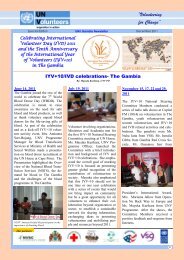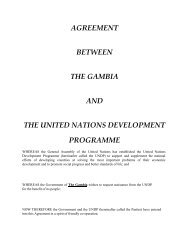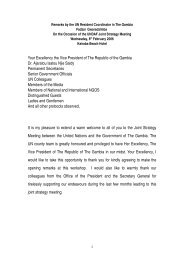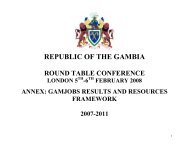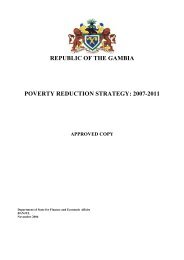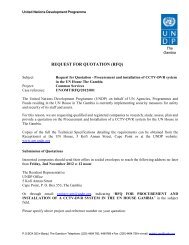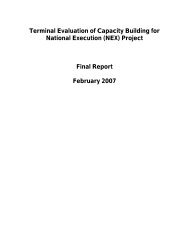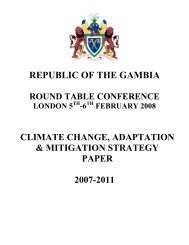Introduction - UNDP The Gambia
Introduction - UNDP The Gambia
Introduction - UNDP The Gambia
Create successful ePaper yourself
Turn your PDF publications into a flip-book with our unique Google optimized e-Paper software.
________________________________________________________________________________________________________________________<br />
4.3.1 NGOs and CBOs in an African<br />
Context<br />
According to the 1995 statistics of the<br />
Commission on Global Governance, there<br />
were, in 1993, 28,900 international NGOs, a<br />
phenomenal increase from the 176 recorded<br />
in 1909 (Huline & Edwards: NGOs, States<br />
and Donors: An Overview, 1997). With<br />
regard to NGOs whose home location is in<br />
the South, their proliferation is not in doubt;<br />
estimates are tentative, but the <strong>UNDP</strong><br />
suggests that in 1993, the figure was close to<br />
50,000 (HDR 1993), rising to hundreds of<br />
thousands when the multiplicities and<br />
grassroots organisations are included.<br />
Several factors lie behind these trends in the<br />
proliferation of NGOs. <strong>The</strong>se are:<br />
• <strong>The</strong>re is the sense that NGOs are<br />
popular, not just with the media and the<br />
public, although that is certainly the<br />
case in the North, but also with<br />
Northern Governments and official aid<br />
agencies. This popularity seems to stem<br />
from the results of a strongly amplified<br />
image in recent years and the belief in<br />
their effectiveness and “comparative<br />
advantage” over other actors.<br />
• Related to the first point is the neoliberal<br />
emphasis on the importance of<br />
markets and private initiative in the<br />
quest for economic growth - the belief<br />
that development and aid provision are<br />
more effective through the private<br />
sector. In this respect, NGOs are seen as<br />
part of the private sector.<br />
• NGOs are seen as having an important<br />
role in the democratisation process and,<br />
in particular, as contributors towards a<br />
thriving civil society.<br />
<strong>The</strong> World Bank’s 1989 Report on sub-<br />
Saharan Africa outlines the prospective<br />
function of NGOs as follows: “<strong>The</strong>y can<br />
create links both upward and downward in<br />
society and voice local concerns…this (will)<br />
bring a broader spectrum of ideas and values<br />
to bear on policy making. <strong>The</strong>y can also exert<br />
pressure on public officials for better<br />
performance and accountability.”<br />
Describing how international financial<br />
institutions and donors can encourage a<br />
greater involvement of organisations outside<br />
government circles, Landell-Mills outlines<br />
the role of NGOs in the scheme of things.<br />
Some NGOs have particular expertise in<br />
working with their counterparts in Africa as<br />
well as directly with community<br />
associations. Official donors that wish to<br />
support grassroots organisations should do so<br />
as “whole sellers”, using the intermediary<br />
NGOs as the “retailers of assistance”.<br />
<strong>The</strong>re is much evidence to suggest that in<br />
many African states the prospects are bleak<br />
for the emergence of a community-based<br />
organisation sufficiently empowered to bring<br />
about significant political change for the<br />
majority of the citizens. <strong>The</strong>re are reasons to<br />
believe that the different ways in which<br />
Western and African societies have evolved<br />
prevent what many see as a “Western model”<br />
being imposed successfully in an African<br />
context.<br />
Whether one believes Ake, who suggests that<br />
Africans are driven to depend on their own<br />
communities because of the failure of the<br />
state, or Mohiddin’s view that African<br />
societies are basically communal, the endproduct<br />
is the same. <strong>The</strong> intricate family and<br />
ethnic associations as well as the deep<br />
cultural, religious and linguistic rifts<br />
identified by Bayart, are seen as major<br />
obstacles to a pluralistic civil society<br />
(Cleobury and Morgan, 2000).<br />
4.3.2 Activities of NGOs in <strong>The</strong><br />
<strong>Gambia</strong><br />
In <strong>The</strong> <strong>Gambia</strong>, NGOs and CBOs have<br />
emerged to fill the gap left by the government<br />
and private sector in terms of ensuring that<br />
the basic needs of the citizenry are met. In<br />
their operations, NGOs have forged a strong<br />
partnership with the Government of <strong>The</strong><br />
<strong>Gambia</strong> in the implementation of national<br />
development programmes towards achieving<br />
the targets of Vision 2020, the MDGs and<br />
PRSP targets. Currently, there are 104 NGOs<br />
registered in the country, which have signed<br />
the protocols of accord.<br />
________________________________________________________________________________________________<br />
Building Capacity for the Attainment of the Millennium Development Goals in <strong>The</strong> <strong>Gambia</strong> National Human Development Report 2005<br />
43


